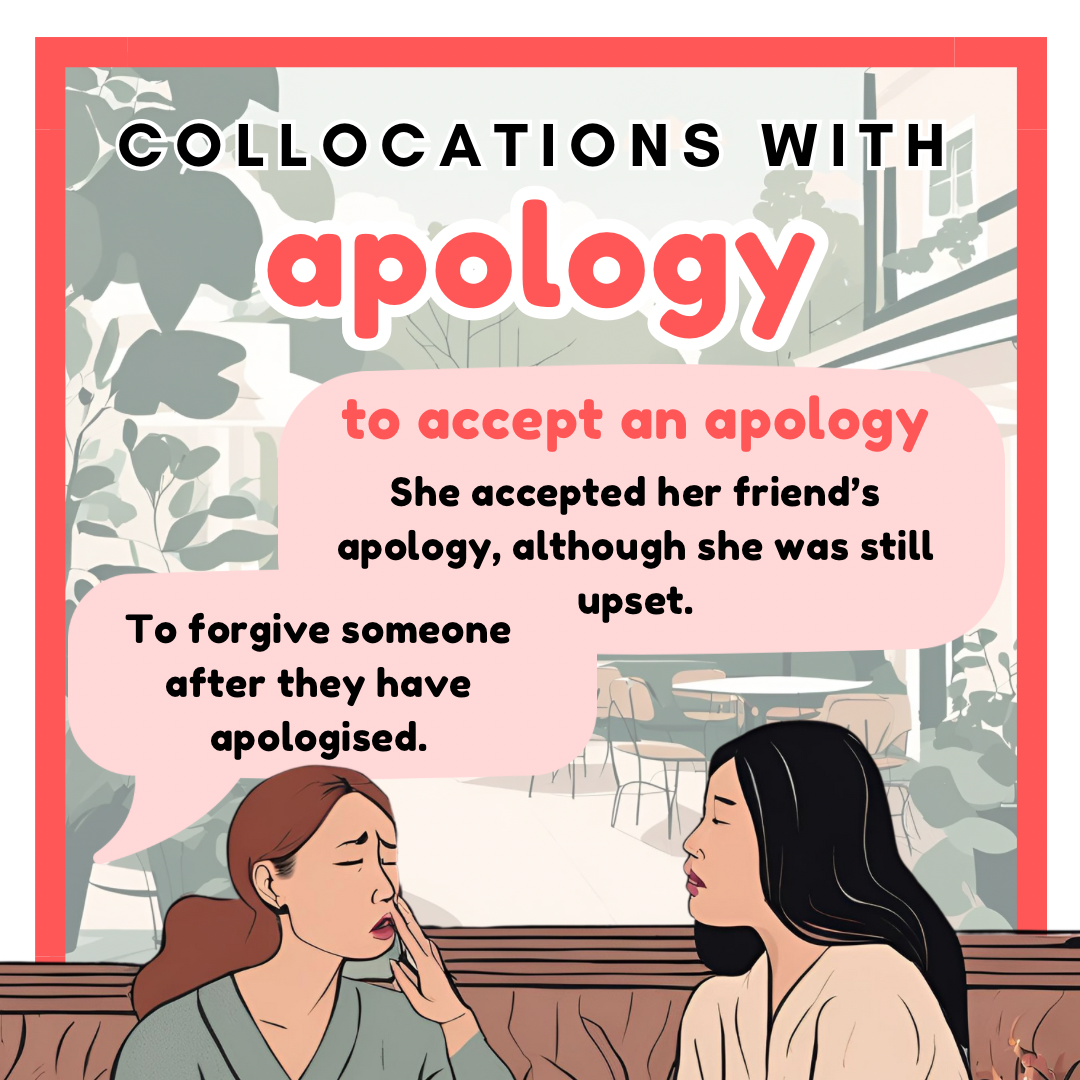Mastering the Art of the Apology in English: 13 Collocations You Need to Know
In English, apologies come in all shapes and sizes—there’s no one-size-fits-all way to say ‘sorry.’ Whether you’ve made a mistake, someone expects an apology from you, or you’re navigating a public mishap, knowing the right language for each situation makes all the difference.
Let’s dive into some key collocations with ‘apology’ to help you communicate more confidently and naturally in English. Each one adds a different shade of meaning, and by using them effectively, you’ll be able to navigate those tricky moments with grace.
1. To accept an apology
When someone apologises to you, you can accept their apology. This means you forgive them and are ready to move on. It’s a simple but powerful way to let the other person know you’re ready to put the issue behind you.
Example: She accepted his apology, but it took her a while to trust him again.
2. A half-hearted apology
A half-hearted apology is one that feels insincere or reluctant. You know the type—when someone says sorry but you can tell they don’t really mean it. It’s not quite what you want to hear, and it often leaves you feeling like the issue isn’t resolved.
Example: His half-hearted apology didn’t fool anyone. It was clear he didn’t think he’d done anything wrong.
3. To owe someone an apology
When you’ve done something wrong, you might owe someone an apology. This phrase highlights the expectation that you need to apologise—it’s like a debt that needs to be paid.
Example: I think you owe Sarah an apology for the way you spoke to her earlier.
4. To expect an apology
Sometimes, when someone has wronged you, you expect an apology. This means you believe they should acknowledge their mistake and say sorry. It's that awkward moment when you're waiting for someone to own up to what they've done.
Example: After the misunderstanding, I expected an apology from him, but it never came.
5. To offer an apology
When you feel responsible for something, you can offer an apology. It’s a more formal way to say that you’ve apologised or are about to.
Example: She offered an apology for arriving late to the meeting, explaining that her train was delayed.
6. A public apology
Sometimes, an apology needs to be made in front of others, often in the media or a large setting. A public apology is usually expected when the offense affects a wider audience.
Example: The politician made a public apology after his controversial statement caused an uproar.
7. A full apology
A full apology is one that acknowledges all aspects of the mistake and takes full responsibility. There’s no sidestepping or excuses here—just a genuine attempt to make amends.
Example: He gave a full apology, admitting to his role in the misunderstanding and offering to make it right.
8. To demand an apology
When you feel wronged and the other person hasn’t acknowledged it, you might demand an apology. This means you’re insisting that the person takes responsibility and says sorry.
Example: The customer demanded an apology after being treated rudely by the staff.
9. To make an apology
This is a general way to describe the act of saying sorry. Making an apology could happen in any setting—whether formal or informal, personal or professional.
Example: He had to make an apology after realising he’d interrupted the speaker during the meeting.
10. A heartfelt apology
A heartfelt apology is one that feels genuine and sincere. When someone really means it, their apology comes from the heart, and you can tell they’ve put thought and emotion into it.
Example: She gave a heartfelt apology for forgetting his birthday, explaining how busy she’d been but still feeling bad about it.
11. A written apology
Sometimes, an apology needs to be more formal or carefully crafted, and that’s when a written apology comes in. This is often used in professional contexts or when you want to make sure the words are just right.
Example: After the incident, the company sent a written apology to all its customers explaining what had happened.
12. To issue an apology
Similar to a written apology, issuing an apology often happens in more formal or public settings. It’s commonly used when organisations or public figures need to address a mistake.
Example: The airline issued an apology after multiple flights were canceled due to technical issues.
13. A sincere apology
A sincere apology is similar to a heartfelt one, but the focus is on honesty. There’s no hidden agenda—just a genuine wish to make things right. It’s the kind of apology that rebuilds trust and helps to move forward.
Example: Her sincere apology made it easier for her friend to forgive and forget the incident.
Whether it’s a sincere apology between friends or a public apology from a public figure, understanding these collocations will help you navigate social and professional situations with confidence. Apologising well is an important skill, and using these phrases can help you express yourself more clearly and effectively in English.
Want to find out more about saying ‘sorry’ in English watch my YouTube video Apologising in British English: Why We Say Sorry So Much













